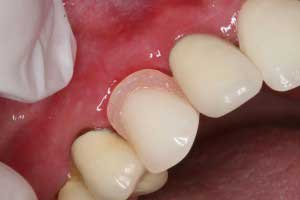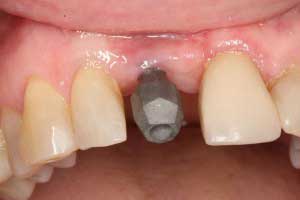A deeply distraught patient shows up to their dental office with a broken tooth. The x-ray reveals a tooth broken off at below the gun line. During the examination the dentist confirms what is shown in the x-ray; the tooth cannot be saved. With a heavy heart the dentist turns to the patient and tells them these dreaded words, “I am sorry. This tooth is non-restorable, and will have to come out!”
“Oh, no! It is a tooth I smile with! Can’t you do anything to replace it?” the patient laments knowing they had neglected that tooth’s decay for some time.
“Of course! We can make it look brand new,” the dentist says smiling a confident smile.
The above dramatization is a common occurrence in dental offices around the world today. Fortunately, dentistry has enjoyed numerous advancements in technology over the past decades. Many of these advancements (dental implants and bone grafting materials) first developed for dentistry have now spilled over into many other medical fields like orthopedics.
Just think about it. Would you let someone “experiment” on your knee to see if a screw was going to work or fail? I would not. Most people do not understand that it was in dentistry that many of these now common technologies were developed. I call the 1980’s and 90’s the “age of human experimentation” in dentistry. There are still some dentists practicing today that pioneered questionable technologies in patient’s mouths to see if they could restore their dentition to a more natural state after their teeth were lost to decay/trauma. Unfortunately, we have all heard of dental implant failures in someone’s mouth in the past. Fortunately, today failures in dental implants are at an all time low.
Today, it is now routine in oral surgery, periodontal and trained general dental offices to remove non-restorable teeth and place inside the extraction site a dental implant. Depending on many factors, the implant is either restored immediately or allowed to heal over a period of time before it is restored. We prefer the latter in most cases because we feel the success rate is much higher. Waiting a few months to allow the bone to heal and osseous integrate to the implant is essential for a long term success rate in most cases.
In general, the implant is placed and then allowed to heal. Then an abutment is placed into the top of the healed implant so a crown can be cemented in the mouth. Meanwhile, the implant came be temporized.
 Temporization of a missing tooth can come in many different forms. Commonly, a transitional partial denture is used to replace any missing teeth. It essentially looks like an orthodontic retainer without the front wire and has a tooth attached to replace the missing teeth esthetically. I call these teeth “Hollywood” teeth because they are just for smiling and not to be used in chewing food. They are made of plastic and have the possibility of breaking. Another popular way is to make an Essix to replace the tooth/teeth. This is a suck down retainer with a tooth placed in the missing areas and acts as “Snap-on” teeth. In certain situations a temporary post type abutment can be fixed to the immediate implant and a temporary crown placed on the newly placed implant. This is only done if there is a good deal of quality implant supporting bone and the temporary is taken out of occlusion.
Temporization of a missing tooth can come in many different forms. Commonly, a transitional partial denture is used to replace any missing teeth. It essentially looks like an orthodontic retainer without the front wire and has a tooth attached to replace the missing teeth esthetically. I call these teeth “Hollywood” teeth because they are just for smiling and not to be used in chewing food. They are made of plastic and have the possibility of breaking. Another popular way is to make an Essix to replace the tooth/teeth. This is a suck down retainer with a tooth placed in the missing areas and acts as “Snap-on” teeth. In certain situations a temporary post type abutment can be fixed to the immediate implant and a temporary crown placed on the newly placed implant. This is only done if there is a good deal of quality implant supporting bone and the temporary is taken out of occlusion.
Care must be taken when removing the tooth from the socket. The extraction should be as “atraumatic” as possible. This will allow as much bone to contact the implant and increase the implant survivability. In many cases, bone grafting material is placed around the neck of the implant(s) and a membrane is placed to insure that the gum tissue will not invade into the socket before the bone grafting material can begin to heal.
During the healing phase it is important to eat healthy foods and clean the area properly.
 After the healing phase is completed the implant is exposed and a temporary healing collar is placed onto the implant and allowed to heal. This allows the gum tissue to heal in a circle around the opening to the implant(s). We use a laser to access the implant in some cases and in others we push the gums back and suture the tissue around the healing collar. It usually depends on what the tissue looks like. It is very important that the implant has the proper type of gum tissue around the final restoration or problems can arise over time like receding gums that can expose the metal implant body and be unattractive during smiling.
After the healing phase is completed the implant is exposed and a temporary healing collar is placed onto the implant and allowed to heal. This allows the gum tissue to heal in a circle around the opening to the implant(s). We use a laser to access the implant in some cases and in others we push the gums back and suture the tissue around the healing collar. It usually depends on what the tissue looks like. It is very important that the implant has the proper type of gum tissue around the final restoration or problems can arise over time like receding gums that can expose the metal implant body and be unattractive during smiling.
After the tissue has healed properly we unscrew the healing collar (without anesthetic) and replace it with a scanning jig.

This is a small part that screws into the implant. We then scan the mouth with our iTero machine which does a digital laser scanning impression of your mouth.
It is the most accurate impression known to mankind. We also take a digital laser bite to insure an accurate fit of the final restoration. The healing collar is replaced and all of the scanning information is sent over the internet to Tel aviv, Israel. There they clean up all the raw scanning data and remove artifacts like cotton rolls and dentist’s fingers. They then send the scanning data to either Ontario, Canada or California, depending on the type of scanning jigs used. There they manufacture a custom abutment attachment that screws into the implant and the crown that cements over the custom abutment.
The restoration process usually takes two weeks to come back from around the world and be placed into the patient’s mouth. At the time of delivery the healing collar is removed (without anesthetic) and the custom abutment is placed. An X-ray is taken to make sure it is all the way seated into the implant body before it is torqued into place. The crown is then cemented in place.
Implant dentistry has advanced a long way since those experimental days of the past. Today, implant dentistry enjoys some of the highest success rates in medicine. More general dentists enter practice having some sort of training in dental implants. Many of them go to post-graduation training programs to learn the subject to the level that in the past only specialists achieved.
The age of dental implants has arrived and has become the first line of treatment for replacing missing teeth. The days of fixed (bridges) and removable (partial and complete dentures) prosthetics are in decline thanks to the marvelous advancements in dentistry over the past decades.
References:
1. Clin Oral Implants Res. 2012 Feb;23 Suppl 5:80-2. doi: 10.1111/j.1600-0501.2011.02370.x. Evidence-based knowledge on the biology and treatment of extraction sockets.Hämmerle CH, Araújo MG, Simion M; Osteology Consensus Group 2011.
2. J Am Dent Assoc. 2012 Feb;143(2):124-33. Immediate postextraction implant placement with immediate loading for maxillary full-arch rehabilitation: A two-year retrospective analysis. Mozzati M, Arata V, Gallesio G, Mussano F, Carossa S. Dr. Mozzati is an oral surgeon and the chief, Oral Surgery Department, Dental School, San Giovanni Battista Hospital-Molinette, Turin, Italy.
3. J Periodontol. 2012 Jan 20. [Epub ahead of print] Immediate Loading of Dental Implants Placed in Severely Resorbed Edentulous Maxillae Reconstructed With Le Fort I Osteotomy and Interpositional Bone Grafting. Pieri F, Lizio G, Bianchi A, Marchetti C, Corinaldesi G. Resident, Department of Oral and Dental Sciences, University of Bologna, Italy, Research assistant, Department of Oral and Dental Sciences, University of Bologna, Italy, Professor of Maxillofacial Surgery, Department of Oral and Dental Sciences, University of Bologna, Italy, Researcher, Department of Oral and Dental Sciences, University of Bologna, Italy.
4. Clin Implant Dent Relat Res. 2012 Jan 17. doi: 10.1111/j.1708-8208.2011.00437.x. [Epub ahead of print] Immediate Occlusal Loading of NanoTite™ Tapered Implants: A Prospective 1-Year Clinical and Radiographic Study. Ostman PO, Wennerberg A, Ekestubbe A, Albrektsson T. Assistant professor, Department of Biomaterials, Institute for Clinical Sciences, Sahlgrenska Academy, Gothenburg University, Gothenburg and Department of DentalMaterials, Malmö University, Malmö, Sweden; professor, Department of Biomaterials, Institute for Clinical Sciences, Sahlgrenska Academy, Gothenburg University, Gothenburg and Department of Dental Materials, Malmö University, Malmö, Sweden, and Department of Prosthodontics, Malmö University Faculty of Odontology, Malmö, Sweden; professor, Department of Oral and Maxillofacial Radiology, Institute of Odontology, The Sahlgrenska Academy at Gothenburg University, Gothenburg, Sweden.
5. Clin Implant Dent Relat Res. 2012 Jan 11. doi: 10.1111/j.1708-8208.2011.00412.x. [Epub ahead of print] Immediate Postextractive Dental Implant Placement with Immediate Loading on Four Implantsfor Mandibular-Full-Arch Rehabilitation: A Retrospective Analysis. Mozzati M, Arata V, Gallesio G, Mussano F, Carossa S. Oral surgeon-Implantologist, Dental School, San Giovanni Battista Hospital Molinette, Turin, Italy; prosthodontist, Department of Biomedical Sciences and Human Oncology, Università di Torino, Turin, Italy.
6. Clin Oral Implants Res. 2012 Feb;23 Suppl 5:39-66. doi: 10.1111/j.1600-0501.2011.02372.x. A systematic review on survival and success rates of implants placed immediately into fresh extraction sockets after at least 1 year. Lang NP, Pun L, Lau KY, Li KY, Wong MC. The University of Hong Kong, Faculty of Dentistry, Prince Philip Dental Hospital, Hong Kong, SAR, China.
7. Implant Dent. 2012 Feb;21(1):62-6. Buccal bone plate in the immediately placed and restored maxillary single implant: a 7-year retrospective study using computed tomography. Degidi M, Nardi D, Daprile G, Piattelli A. *Private Practice, Via Spina, Bologna, Italy. †Full Professor of Oral Pathology, Dental School, University of Chieti, Via F. Sciucchi, Chieti, Italy.
8. Clin Oral Implants Res. 2012 Jan 6. doi: 10.1111/j.1600-0501.2011.02394.x. [Epub ahead of print] Changes in soft tissues around immediate full-arch rehabilitations: a prospective study. Covani U, Ricci M, D’Ambrosio N, Quaranta A, Barone A. Department of Surgery, University of Pisa, Pisa, Italy.
9. J Oral Implantol. 2011 Dec 28. [Epub ahead of print] Implant Placement and Immediate Loading with Fixed Restorations in Augmented Sockets. Five-year Results. A Case Report.
Zafiropoulos GG, Deli G, Vittorini G, Hoffmann O. a Dental Center Blaues Haus, Head, Periodontics, Dental Center Blaues Haus.
10. Int J Periodontics Restorative Dent. 2011 Nov-Dec;31(6):e109-17. Microbiologic evaluation of compromised periodontal sites before and after immediateintrasocket implant placement. Tripodakis AP, Nakou M. Department of Prosthodontics, School of Dental Medicine, National and Kapodistrian University of Athens, Athens, Greece. tripod.dental@hotmail.com
